Introduction
Sustainable or Green housing design involves designing buildings that have the least impact on the environment. These buildings need to ensure that the impact on the environment is the least with reference to the carbon dioxide released, energy consumed, amount of water used, waste generated and disposed of and the materials used for construction. This paper discusses the design of sustainable housing and provides plan samples, details of materials used, waste disposal system and how the expected costs of the buildings.
Requirements of Sustainable Buildings
The Department for Communities and Local Government, London has released a code for sustainable design and this guide provides all the technical requirements for buildings that have to be designated as green buildings (Code, September 2007). The paper would use these specifications in framing the design. Areas of the building that would be covered include Energy and CO2 Emission, Water, Materials, Surface Water Run-off, Waste, Pollution and costs.
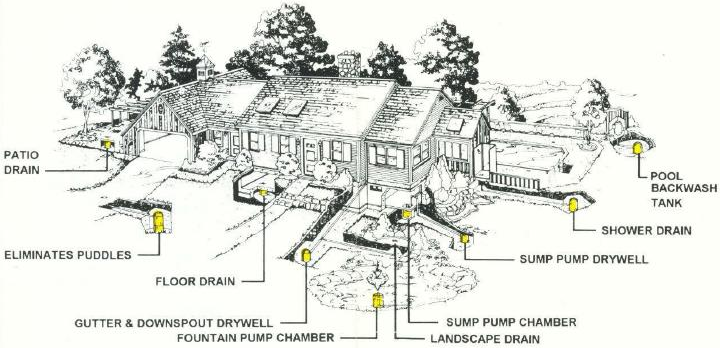
Design of the Sustainable House
Modular homes form one of the best alternatives when it comes to designing a sustainable house as it is cost-effective, requires lesser time to build, is rigid and can be customized easily to meet specific requirements. With advances in technology, construction material and manufacturing processes, modular housing is aesthetically appealing, has intricate designs and is suitable for homes, offices as well as large buildings. Modular housing needs to conform to HUD specifications as well as any local specifications. A wide range of plans and materials are available to allow modular homes to be used for sustainable housing (UVA. 13 February 2008).
Sample Plan
The plan of the modular sustainable house is shown below. The roof of the house has solar panels for the optional generation of electricity for use during summer.
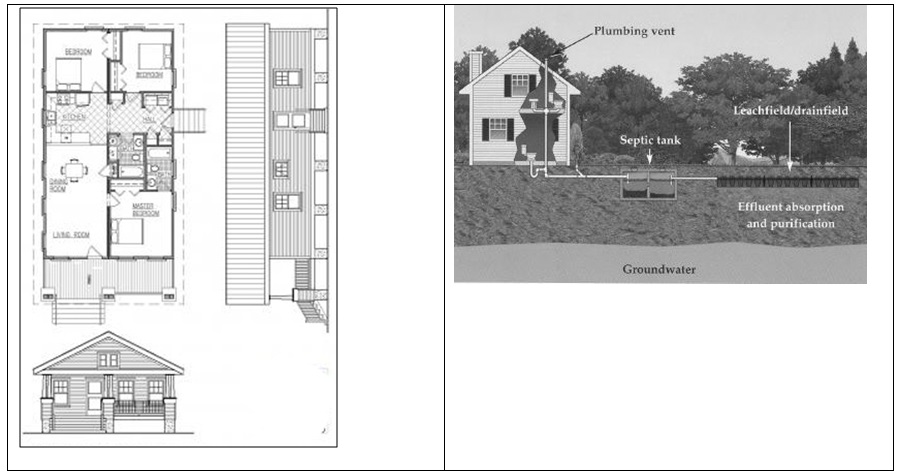
The right image shows details of the waste treatment plant. Details of the building will be explained in the next sections.
Design of Waste Treatment
As per the specifications of the Code for Sustainable Homes (Code, 2007), wastewater must be effectively treated before it is disposed into the environment. The wastewater is regarded as affluent and consists of blackwater or toilet waste and greywater that includes kitchen, shower, sink, and laundry waste. In the sustainable design, effluent flows directly from the house into a watertight, underground, two-compartment septic tank. Solid waste settles into a sludge layer on the bottom and fats float to the top of the first compartment. Between these two scum layers is a zone of clarified liquid effluent, which is internally piped to the second compartment of the septic tank for additional settling. As incoming sewage from the house fills the first compartment, clarified liquids are forced to leave the second chamber of the septic tank and flow out to the leach field or leach pit. The typical leach field is a series of shallow rock-filled trenches where effluent is “purified” as it slowly percolates through the soil. A leach pit is a deeper, larger hole filled with rock for disposing of wastewater. An illustration is shown in the following figure.
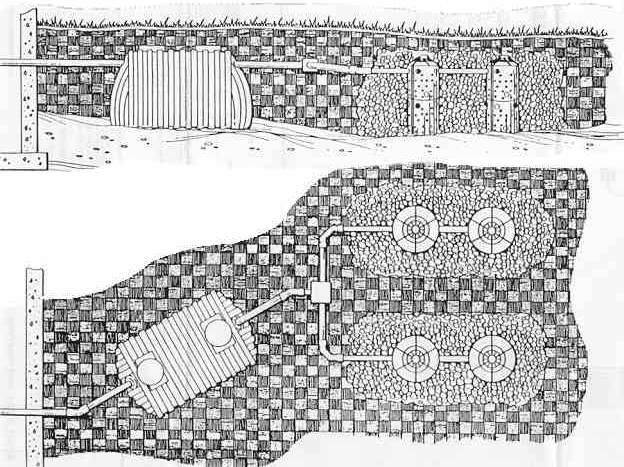
The following equation should be considered while calculating the absorption capacity of the system. If the system is less than adequate, then the untreated wastewater would percolate into the groundwater.
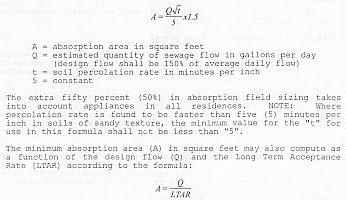
Solar Panels and Passive Solar Homes
Chiras (2006) has pointed out that for a sustainable design, solar energy needs to be harnessed by using solar kits that convert solar energy to electric energy. Modular kits are available in various power outputs from 1 to more than 200 watts and this power is sufficient for a house. The home can be connected to the electricity network and any extra solar power that is generated can be given back to the grid to earn credits. In addition, the author suggests that the overall design of the house should be such that sunlight must be allowed to enter by using large sloped windows with glasses. An illustration is shown in the following figure.
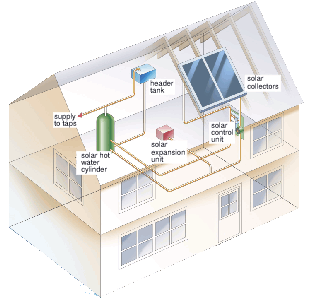
The author has also suggested that where possible, wind turbines can be used to provide additional renewable electricity. The author admits that solar power may not be feasible in winter but the system can be used for some months in a year.
Construction Panels and Materials
Sustainable modular homes can be finished to give them an excellent look. Traditional materials used included natural softwood and hardwood. A number of alternative structural materials have been introduced and these are classified as Engineered Lumber and Structural Steel. Engineered Lumber includes materials such as laminated Veneer Lumber, Wooden I Beams, Structural Composite Lumber and steel products include prefabricated trusses, finger-jointed studs and steel. Items such as foundation, walls, ceilings and other materials have to be constructed from eco-friendly material that is made from recycled substances. Some materials are given below (Edwards, 2000).
Walls
The Durisol Wall Form System is an insulated concrete forming system with built-in thermal, acoustical and fire protection. It uses a cement-bonded wood fibre material that is neutralized, mineralized and bonded together with Portland cement. Durisol is environmentally safe, does not contain nor emit any toxic elements, no VOCs or CFCs, contains no plastic, foams or polystyrenes, does not rot or decay and is fully recyclable. The wood fibre used is clean and unused softwood lumber taken from post-industrial sources, that would have otherwise been sent to the landfill. The forms use mineral fibre insulation that is non-combustible, moisture-resistant and positioned towards the exterior of the wall, resulting in additional energy efficiency and cost savings. Interior and exterior finishes can be applied directly to the Durisol material, eliminating subsequent steps in the construction process, making it more efficient. It is also more efficient during the construction process because it is stronger than most alternatives, there are zero blowouts and construction can take place all year round (Edwards, 2000).
Eco Block
ECO-Block Insulating Concrete Form is advanced construction technology. ICFs are hollow blocks or panels made of Expanded Polystyrene (EPS) that a construction crew stacks to create the exterior walls of a residential or commercial building. Workers then add reinforcing steel and fill the gap between the two layers of foam with concrete. This combination of concrete, steel and foam creates a very strong and energy-efficient structure. After the concrete has hardened, the forms stay in place and become the insulation for the walls (Edwards, 2000).
An illustration of the front view of the building is given in the following figure.
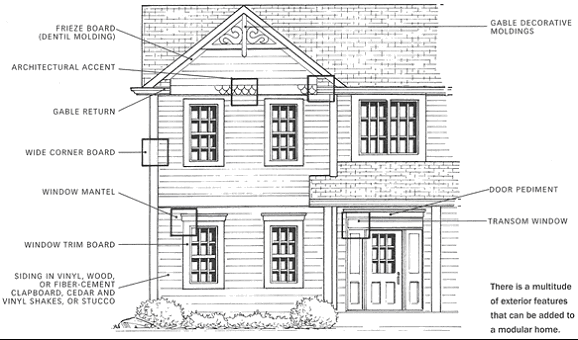
Additional Design considerations
Interiors and exteriors design should strike a balance between factors such as utility, aesthetics and cost. This section gives an overview of different key elements. The manufacturer can provide the items as accessories or they can be bought from other sources and fitted (Stang, 2005).
- Trusses: These would be supporting the ceiling and need to be rigid and strong enough to take the load. There are two types of trusses: Web and Storage. Web trusses do not allow any storage while Storage trusses allow items to be tucked inside.
- Foundation and Sill Plate
- Insulation and House wrap, fireplaces, HVAC.
- Roof System: Different elements of roof systems are Roof pitch, Hip roo, Roof framing, Attic storage, Attic bath floor trusses, Roof sheathing and overhang, Decorative gables, Ice and water shield, Attic ventilation and others.
- Exterior finishes: Different elements are Siding, Exterior Trim, Shutters, Decorative exterior mouldings and Roofing.
- Windows: In cold areas, energy efficiency and internal heat loss prevention are very important. Choices are Vinyl or wood frame, Single-hung, double-hung, or casement, Tilt-in function, Window colour and size, Skylights and sun tubes.
- Doors: These would include exterior doors, Main entry doors, Accessible entries, French doors and sliders special doors.
- Electrical wiring: These include Electrical panel boxes, Electrical switches, Phone and cable jacks, Thermostat wires, special wiring. Suitable fireproofing needs to be done.
- Ceilings: Ceiling height is limited as per the design consideration. Choices for ceilings include sloped ceiling, tray-type and vaulted and cathedral ceilings can be specified.
- Lighting and electrical fixtures: These can be purchased from electrical hardware shops and include items such as Interior light fixtures, Recessed lights, energy-efficient lights, basement/ interior and exterior lights, Ceiling and exhaust fans, fire and smoke detectors and others. The placement of these fixtures needs to be specified in the plan.
- Plumbing: Plumbing is a very important feature while designing a house. Easy access for maintenance and repairs is important. The main elements are drain, waste, and vent material, Kitchen-sink cleanout, Shut-off valves, Laundry tub, toilet fittings, faucets and taps.
- Flooring: A wide choice of veneers, carpets, wood or laminate flooring can be applied to the manufactured flooring.
- Stairs and railings: When the Ist floor is raised, either steps or a staircase can be fitted. When two floors are present then different staircases such as straight stairs, L stairs, wraparound stairs, U stairs, stair railings and others can be fitted. Stairs can be made of wood with matching railings.
- Kitchens: This is an important area and kitchen fittings such as Kitchen cabinets, Soffits above wall cabinets, Kitchen countertops, sinks, faucets and space for cooking range and oven can be specified.
- Bathrooms: Depending on the number of rooms, family members, the number of bathrooms can be specified in the plan. Bathroom interiors such as Bath vanity, Bathroom countertops, sinks, and faucets, Medicine cabinets, mirrors, lights, Toilets, Grab bars, Tubs and showers can be specified.
Costs
Lombard (April 2006) has suggested that sustainable modular houses are very economical when compared to regular sustainable housing. In addition to being sustainable, the houses would be able to withstand winds of 300 kilometres per hour and also withstand earthquakes. The cost may not include the land cost as this may vary from a few hundred dollars to thousands of dollars, depending on the site. As a ‘ballpark figure’ the following figures can be considered as a base. Actual prices may differ from time to time
Table 1. Estimated costs of Sustainable Housing (D & G, 2006).
Conclusion
The paper has provided the basic design elements of sustainable housing and discussed various aspects such as wastewater treatment, electricity generation through solar power, use of modular construction and provided rough cost estimates.
References
Code. 2007. Code for Sustainable Homes: Technical Guide. Web.
CIWMB. 2007. Sustainable Building Tool Kit. Web.
Chiras Dan. 2006. The Homeowner’s Guide to Renewable Energy: Achieving Energy Independence through Solar, Wind, Biomass and Hydropower. New Society Publishers. ISBN-10: 086571536X.
D & G. 2006. Modular Homes Price List. Web.
Edwards Brian. 2000. Sustainable Housing: Principles and Practice. Taylor & Francis. ISBN-10: 0419246207
Lombard Mark. 2006. Prefabricated Modular Buildings: An Architectural Revolution in Surrey. Web.
Stang Alanna. 2005. The Green House: New Directions in Sustainable Architecture. Princeton Architectural Press. ISBN-10: 1568984812.
UVA. 2008. ecoMOD3 Expands Modular, Sustainable, Affordable Housing Research. Web.